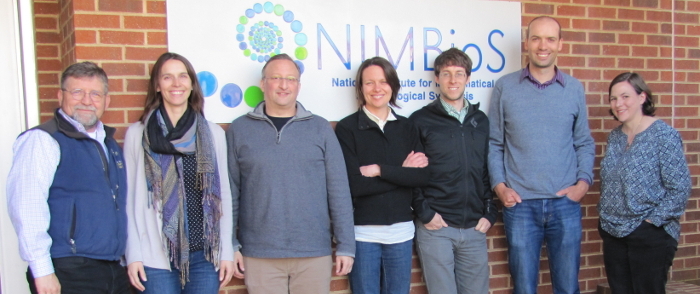| Description | Participants | Summaries | Products |
|---|

Archived NIMBioS Working Group
Computational Landscape Genomics
Topic: Addressing the computational challenges in landscape genomics
Meeting dates: May 13-16, 2014; June 3-6, 2015; March 21-23, 2016
Organizers:
Andrew Storfer, Biological Sciences, Washington State Univ., Pullman
Gilles Guillot, Applied Mathematics, Technical Univ. of Denmark, Copenhagen
Mike Antolin, Biology, Colorado State Univ., Fort Collins
Mary Poss, Biology, Penn State Univ., University Park
Objectives:
As we move forward in the genomic age, we can rapidly sequence complete genomes and transcriptomes, as well as assay genomic structural features (e.g., gene copy number variants, transposable elements), of virtually any species. Advances in genomics provide new avenues for understanding the genetic basis of functionally adaptive trait variation. For example, we have made great strides in understanding adaptation to extreme environments and the genetic basis for many diseases in human populations, as well as in non-model organisms. However, scientists are awash with data, and methods to unlock the power of genome projects are still under development.
Rapid advances in our ability to obtain genomic data have also caused a paradigm shift in the way we view "genes." Once thought to be directly related to phenotype, genes operate in complex genomic landscapes, rather than in isolation. A gene's location and copy number within a genome may regulate its expression, as well as its interaction with other genes and noncoding RNA. The complexity of the genomic landscape is compounded by the environment in which an individual persists. Genes are expressed differently in different environments, and selection varies spatially across the ecological landscape. A major challenge, then, is to analyze data sets that integrate both the genomic landscape and the ecological landscape to understand the spatial distribution of adaptive genetic variation. This working group will address this challenge by advancing analytical and computational methods with an interdisciplinary collaboration of experts in genomics, statistics, mathematics, bioinformatics and population genetics.

Meeting Summaries
| Mtg # | Dates | Agenda | Summary | Photo | Evaluation |
|---|---|---|---|---|---|
| 1 | May 13-16, 2014 | Link | Link | Report | |
| 2 | Jun 3-6, 2015 | Link | Link | ||
| 3 | Mar 21-23, 2016 | Link |
Meeting 1 Summary. During the first meeting, we reviewed the computational challenges associated with the recent advances in genomics that provide new avenues for understanding the genetic basis of functionally adaptive trait variation. Our focus was on understanding the integration of the genomic landscape, or the architecture of the genome itself, and the ecological landscape, or the spatial landscape where variation exists in gene frequencies and gene expression among individuals. We refer to this integration as “landscape genomics,” and our meeting centered around addressing four specific issues: 1) gaining a better understanding of how to detect genomic structural variation and its relationship to phenotypic variation; 2) improving computational methods for incorporating population demographic history in detection of selection across ecological space; 3) developing additional methods to detect correlations of loci from genome scans with environmental variables; and, 4) creating simulations to study spatial selection on genomes using repeated colonization events.
Meeting 2 Summary. During the second meeting, the group reviewed progress from the previous meeting, which included development of a (hexsim) model of landscape genomics colonization and adaptation. As we continued to focus on understanding the integration of the genomic landscape and the spatial ecological landscape, we came to the realization that many new methodologies for testing genome scan data for selection have been published in recent years. Our group agreed that a productive way to focus our efforts was to write a manuscript that both served to review the current methodologies, appropriate uses and power of each, as well as to offer a perspective on how to proceed with study design and analysis into the future to improve landscape genomics studies.
 |
| Meeting 1 participants: (Back, L to R) Thomas Mitchell-Olds, Angela Hancock, Michael DeGiorgio, Ryan Martin, Joanna Kelly, Laura Reed, Mary Poss, Andrew Storfer, David Lowry; (Front, L to R) Subhash Lele, Michael Antolin, Sean Hoban, Gilles Guillot. Not Pictured: Barbara Engelhardt |
 |
| Meeting 2 participants: (L to R) Michael Antolin, David Lowry, Gideon Bradburd, Sean Hoban, Mary Poss, Michael Whitlock, Andrew Storfer, Laura Reed. Not Pictured: Joanna Kelley. |
 |
| Meeting 3 participants: (L to R) Michael Antolin, Joanna Kelly, Andrew Storfer, Katie Lotterhos, Sean Hoban, David Lowry, Laura Reed. |
NIMBioS Working Groups are chosen to focus on major scientific questions at the interface between biology and mathematics. NIMBioS is particularly interested in questions that integrate diverse fields, require synthesis at multiple scales, and/or make use of or require development of new mathematical/computational approaches. NIMBioS Working Groups are relatively small (up to 10 participants), focus on a well-defined topic, and have well-defined goals and metrics of success. Working Groups will meet up to 3 times over a two-year period, with each meeting lasting up to 2.5 days.
A goal of NIMBioS is to enhance the cadre of researchers capable of interdisciplinary efforts across mathematics and biology. As part of this goal, NIMBioS is committed to promoting diversity in all its activities. Diversity is considered in all its aspects, social and scientific, including gender, ethnicity, scientific field, career stage, geography and type of home institution. Questions regarding diversity issues should be directed to diversity@nimbios.org. You can read more about our Diversity Plan on our NIMBioS Policies web page. The NIMBioS building is fully handicapped accessible.
NIMBioS
1122 Volunteer Blvd., Suite 106
University of Tennessee
Knoxville,
TN 37996-3410
PH: (865) 974-9334
FAX: (865) 974-9461
Contact NIMBioS


